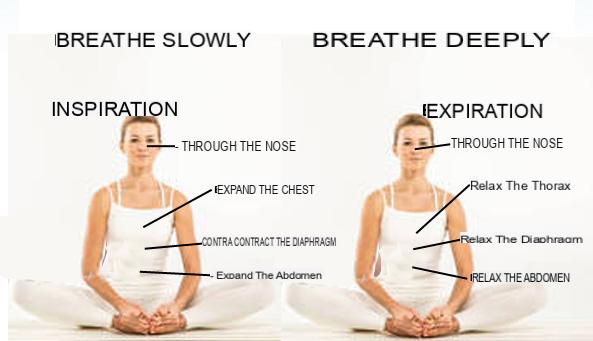
Introduction
When it comes to cramps, most people immediately think of involuntary and sudden contractions of the leg muscles. Typical, for example, are those on the feet and calves.
But there are also abdominal cramps: painful spasms in the abdomen which can be linked to various causes, such as painful menstruation, meteorism, gastroenteritis, stomach ache, psychosomatic discomfort, digestive problems, real muscle cramps in the core muscles (especially the rectus abdominis) or in the diaphragm.
In all cases, to relieve symptoms and get some relief it is possible to perform specific breathing exercises against abdominal cramps.
What they depend on
Abdominal cramps can have many different causes. Here are some of the most common.
Menses
For some women, menstruation does not cause particular discomfort, while for others it is so painful that it prevents normal activities. In these cases we speak of dysmenorrhea. Generally, the pains and cramps associated with menstrual flow appear in the lower abdomen or lumbar area shortly before menstruation and then continue for its entire duration.
Gastroenteritis
It is the simultaneous inflammation of the mucous membrane of the stomach and that of the intestine. Often, the culprits of the problem are viruses or bacteria transmitted through infected food and water or through the droplets of salive emitted by infected people.
In all cases, stomach pain, vomiting, diarrhea and abdominal cramps appear. Sometimes, fever and fatigue can also occur.
Indigestion
Indigestion can cause abdominal pain and tension, fullness, heartburn, regurgitation of acidic juices, nausea, vomiting, cold sweats, upper abdominal cramps, headache, general malaise.
Meteorism
A buildup of gas in the belly can cause intestinal muscles to spasm. If you suffer from meteorism, you may also have: distended stomach, severe bloating, stomach pain, feeling of fullness, belching.
Muscle strain
Overloading of the abdominal muscles, due to intense training or overexertion, could also cause abdominal spasms. Spasms due to muscle strain are more likely in people who exercise frequently and strenuously. In this case, there is also usually pain in the abdominal muscles that gets worse with movement.
Dehydration
Loss of electrolytes caused by sweating, vomiting, or diarrhea can cause muscle spasms throughout the body, including the abdomen and stomach. This happens because the muscles need electrolytes such as calcium, potassium and magnesium to function properly. When they don't have these electrolytes, muscles may start working abnormally and freeze.
Intestinal diseases
Bowel diseases, such as Crohn's disease, enteritis, ulcerative colitis (UC), can cause intestinal spasms.
Useful exercises
To relieve the pain and discomfort associated with abdominal cramps, it is very helpful to focus on breathing by doing specific exercises. In particular, this practice is indicated against menstrual cramps, but not only. Here are some effective breathing exercises for abdominal cramps.
Mindful breathing
Centering your breath and focusing your attention on it can help ease the pain of abdominal cramps.
- Start by doing a few cycles of normal breathing.
- On your next inhalation, take a slow, gentle, deep breath through your nose.
- Then take a slow, gentle, deep exhalation through your nose.
- Return to normal breathing for a few cycles.
- Then, repeat the deep inhalation and exhale again, returning to normal breathing again.
- Complete a total of 10 cycles.
The breath of the victorious
The breath of the victorious or Ujjayi pranayama It is a type of breathing that is practiced in yoga and that regulates blood pressure and can help prevent cramps.
- Start by breathing naturally but with awareness for a few cycles.
- Then continue to inhale normally, but exhale deeply until the lungs are completely empty.
- Repeat for 15 cycles.
- Then, inhale deeply and exhale normally for another 15 cycles.
- Finally, inhale and exhale deeply for 20 cycles.
- Rest by returning to normal breathing for several cycles.
Fractional breathing
Viloma Pranayama Fractional Breathing is another type of yoga breathing that soothes anxiety as well brings lightness and balance to the body. This is why it is among the breathing exercises for abdominal cramps recommended by experts.
- Begin by inhaling and exhaling naturally.
- On the next inhalation, pause for 2 seconds, then exhale fully.
- Repeat for 7-10 minutes until you feel fatigued.
- Try to fill your lungs with more air each time you inhale.
- Rest with 3 minutes of normal breathing.
Fractional breathing 2
The Viloma 2 pranayama breathing exercise is also an effective treatment for abdominal cramps, especially when related to menstrual flow.
- Begin by inhaling and exhaling naturally through the nose.
- After the next exhalation, pause for 2 seconds before inhaling.
- Repeat up to 5 times.
You can perform this breathing exercise while sitting or lying down. If you are lying down, support your chest and raise your head with pillows to deepen your breath. Make sure your head is slightly higher than your chest.


























